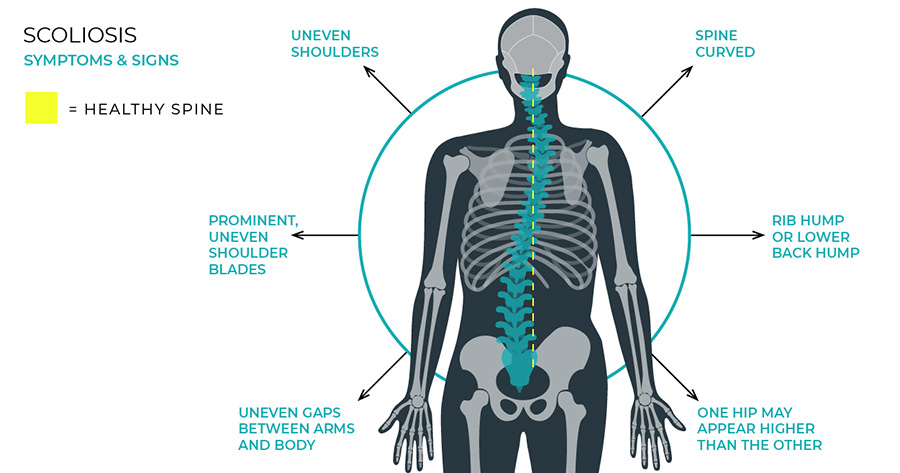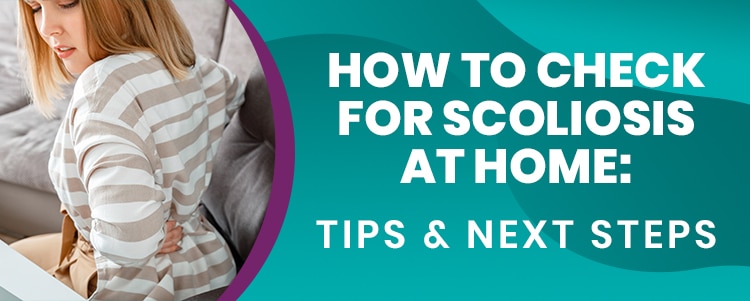Scoliosis is a medical condition characterized by an abnormal curvature of the spine. It can affect people of all ages, but it most commonly develops during adolescence. While some cases of scoliosis are mild and do not require treatment, others can progress and cause significant discomfort and health issues. Early detection is crucial in managing scoliosis effectively. By learning how to check for scoliosis at home, individuals can play an active role in monitoring their spinal health and seeking appropriate medical attention when necessary.

Understanding the importance of early detection
Early detection of scoliosis is vital for several reasons. Firstly, it allows for timely intervention and treatment, which can prevent the progression of the curvature and minimize potential complications. Secondly, early detection enables individuals to adopt corrective measures, such as exercises and physical therapy, to improve their spinal alignment and overall posture. Lastly, identifying scoliosis early on can provide peace of mind and alleviate anxiety associated with undiagnosed symptoms.
Preparing for a self-screening at home
Before embarking on a self-screening for scoliosis, it is essential to create an appropriate environment. Find a well-lit room with a full-length mirror that allows you to observe your entire body. Wear form-fitting clothing, such as a sports bra and leggings or shorts, to ensure clear visibility of your body’s contours. It is also helpful to have a friend or family member present to assist with observations and provide a second opinion if needed.

Method 1: Visual inspection for scoliosis signs
Begin the self-screening process by visually inspecting your body for signs of scoliosis. Stand with your feet shoulder-width apart and your arms relaxed at your sides. Observe your body from the front, back, and sides. Look for any noticeable asymmetry, such as one shoulder being higher than the other, one hip appearing more prominent, or an uneven waistline. Take note of any visible curvature or rotation of the spine.
Method 2: Self-assessment of spinal alignment
Next, assess your spinal alignment by standing with your back against a wall. Ensure that your heels, buttocks, shoulders, and head are all touching the wall. Slowly slide your hand between the small of your back and the wall. If you can easily fit your hand in this space, it may indicate a potential curvature in your spine.
Method 3: Checking for uneven shoulder heights
Stand in front of a mirror and observe your shoulder heights. Raise your arms to shoulder level and check if one shoulder appears higher than the other. Uneven shoulder heights can be an indication of scoliosis.
Method 4: Assessing the symmetry of the waistline
Stand with your back to the mirror and observe your waistline. Look for any asymmetry or unevenness in the waistline. If one side appears higher or more prominent than the other, it could be a sign of scoliosis.
Method 5: Identifying abnormal curves in the back
While facing away from the mirror, bend forward at the waist with your arms hanging loosely towards the floor. Observe your back for any abnormal curves or humps. If you notice a significant curvature or hump on one side of your back, it may indicate scoliosis.
Method 6: Self-checking for rib prominence or hump
Stand sideways to the mirror and observe your ribcage. Look for any protrusion or hump on one side of your back. If you notice a visible rib prominence or hump, it could be a sign of scoliosis.
Method 7: Evaluating posture and body alignment
Lastly, assess your overall posture and body alignment. Stand naturally and observe if your head, shoulders, hips, and feet are aligned vertically. Pay attention to any noticeable tilting or leaning to one side. Poor posture and misalignment can be indicative of scoliosis.
Recognizing common scoliosis symptoms and warning signs
In addition to the physical observations mentioned above, it is crucial to be aware of common scoliosis symptoms and warning signs. These may include back pain, muscle stiffness, uneven leg lengths, difficulty breathing, and fatigue. If you experience any of these symptoms, it is essential to seek professional medical evaluation.
When to seek professional medical evaluation
While self-screening at home can provide valuable insights, it is important to remember that it does not replace a professional medical evaluation. If you notice any signs or symptoms of scoliosis during your self-screening, it is recommended to consult a healthcare provider or a scoliosis specialist for a thorough examination. They can provide an accurate diagnosis, determine the severity of the condition, and recommend appropriate treatment options.
In conclusion, learning how to check for scoliosis at home empowers individuals to take an active role in monitoring their spinal health. By following simple methods and techniques for self-screening, such as visual inspection, self-assessment of spinal alignment, checking for uneven shoulder heights and waistline symmetry, identifying abnormal curves in the back, self-checking for rib prominence or hump, and evaluating posture and body alignment, individuals can detect potential scoliosis symptoms early on. However, it is crucial to remember that self-screening does not replace professional medical evaluation. If any signs or symptoms of scoliosis are present, seeking medical attention is essential for accurate diagnosis and appropriate treatment.
References
- Weinstein, S. L., Dolan, L. A., Cheng, J. C., et al. “Adolescent idiopathic scoliosis.” Lancet. 2008;371(9623):1527-1537. doi: 10.1016/S0140-6736(08)60658-3
- Hresko, M. T. “Clinical practice. Idiopathic scoliosis in adolescents.” New England Journal of Medicine. 2013;368(9):834-841. doi: 10.1056/NEJMcp1209063
- Negrini, S., Donzelli, S., Aulisa, A. G., et al. “2016 SOSORT guidelines: Orthopaedic and rehabilitation treatment of idiopathic scoliosis during growth.” Scoliosis and Spinal Disorders. 2018;13:3. doi: 10.1186/s13013-018-0175-8
- Bunnell, W. P. “Selectivity in screening for scoliosis.” Journal of Bone and Joint Surgery. 2005;87(9):1957-1962. doi: 10.2106/00004623-200509000-00001
- Lonstein, J. E., Carlson, J. M. “The prediction of curve progression in untreated idiopathic scoliosis during growth.” Journal of Bone and Joint Surgery. 1984;66(7):1061-1071. doi: 10.2106/00004623-198466070-00008
- Richards, B. S., Vitale, M. G. “Screening for idiopathic scoliosis in adolescents: An information statement.” Journal of Bone and Joint Surgery. 2008;90(1):195-198. doi: 10.2106/JBJS.H.00452
- Sanders, J. O., Newton, P. O., Browne, R. H., et al. “Preoperative trunk deformity in patients with idiopathic scoliosis.” Spine. 2003;28(14):1585-1591. doi: 10.1097/01.BRS.0000070452.07893.8B
- Miller, M. D., Thompson, S. R. DeLee & Drez’s Orthopaedic Sports Medicine: Principles and Practice. 5th ed. Philadelphia: Elsevier; 2019.
- U.S. Preventive Services Task Force (USPSTF). “Screening for Adolescent Idiopathic Scoliosis: Recommendation Statement.” JAMA. 2018;319(2):165-172. doi: 10.1001/jama.2017.19342
- Skaggs, D. L., Early, S. D., D’Ambra, P., et al. “The incidence of post-surgical complications in scoliosis surgery based on a prospective pediatric scoliosis database.” Journal of Pediatric Orthopaedics. 2002;22(2):214-217. doi: 10.1097/01241398-200203000-00016

